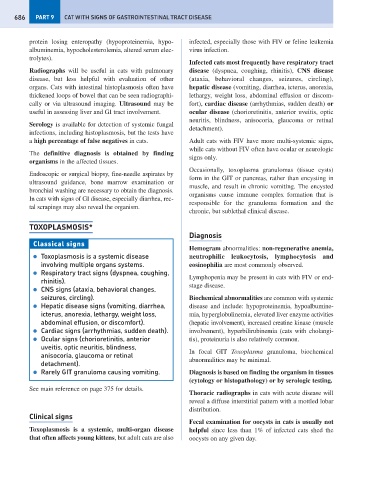Page 694 - Problem-Based Feline Medicine
P. 694
686 PART 9 CAT WITH SIGNS OF GASTROINTESTINAL TRACT DISEASE
protein losing enteropathy (hypoproteinemia, hypo- infected, especially those with FIV or feline leukemia
albuminemia, hypocholesterolemia, altered serum elec- virus infection.
trolytes).
Infected cats most frequently have respiratory tract
Radiographs will be useful in cats with pulmonary disease (dyspnea, coughing, rhinitis), CNS disease
disease, but less helpful with evaluation of other (ataxia, behavioral changes, seizures, circling),
organs. Cats with intestinal histoplasmosis often have hepatic disease (vomiting, diarrhea, icterus, anorexia,
thickened loops of bowel that can be seen radiographi- lethargy, weight loss, abdominal effusion or discom-
cally or via ultrasound imaging. Ultrasound may be fort), cardiac disease (arrhythmias, sudden death) or
useful in assessing liver and GI tract involvement. ocular disease (chorioretinitis, anterior uveitis, optic
neuritis, blindness, anisocoria, glaucoma or retinal
Serology is available for detection of systemic fungal
detachment).
infections, including histoplasmosis, but the tests have
a high percentage of false negatives in cats. Adult cats with FIV have more multi-systemic signs,
while cats without FIV often have ocular or neurologic
The definitive diagnosis is obtained by finding
signs only.
organisms in the affected tissues.
Occasionally, toxoplasma granulomas (tissue cysts)
Endoscopic or surgical biopsy, fine-needle aspirates by
form in the GIT or pancreas, rather than encysting in
ultrasound guidance, bone marrow examination or
muscle, and result in chronic vomiting. The encysted
bronchial washing are necessary to obtain the diagnosis.
organisms cause immune complex formation that is
In cats with signs of GI disease, especially diarrhea, rec-
responsible for the granuloma formation and the
tal scrapings may also reveal the organism.
chronic, but sublethal clinical disease.
TOXOPLASMOSIS*
Diagnosis
Classical signs
Hemogram abnormalities: non-regenerative anemia,
● Toxoplasmosis is a systemic disease neutrophilic leukocytosis, lymphocytosis and
involving multiple organs systems. eosinophilia are most commonly observed.
● Respiratory tract signs (dyspnea, coughing,
Lymphopenia may be present in cats with FIV or end-
rhinitis).
● CNS signs (ataxia, behavioral changes, stage disease.
seizures, circling). Biochemical abnormalities are common with systemic
● Hepatic disease signs (vomiting, diarrhea, disease and include: hypoproteinemia, hypoalbumine-
icterus, anorexia, lethargy, weight loss, mia, hyperglobulinemia, elevated liver enzyme activities
abdominal effusion, or discomfort). (hepatic involvement), increased creatine kinase (muscle
● Cardiac signs (arrhythmias, sudden death). involvement), hyperbilirubinemia (cats with cholangi-
● Ocular signs (chorioretinitis, anterior tis), proteinuria is also relatively common.
uveitis, optic neuritis, blindness,
anisocoria, glaucoma or retinal In focal GIT Toxoplasma granuloma, biochemical
detachment). abnormalities may be minimal.
● Rarely GIT granuloma causing vomiting. Diagnosis is based on finding the organism in tissues
(cytology or histopathology) or by serologic testing.
See main reference on page 375 for details.
Thoracic radiographs in cats with acute disease will
reveal a diffuse interstitial pattern with a mottled lobar
distribution.
Clinical signs
Fecal examination for oocysts in cats is usually not
Toxoplasmosis is a systemic, multi-organ disease helpful since less than 1% of infected cats shed the
that often affects young kittens, but adult cats are also oocysts on any given day.

